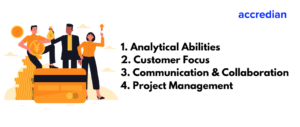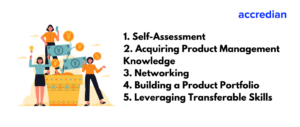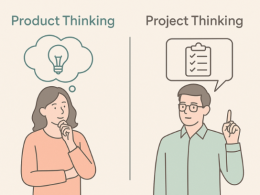Are you a banking professional seeking an exhilarating career change that taps into your analytical acumen, customer focus, and strategic mindset?
Have you ever wondered if there’s a path that combines your financial expertise with the excitement of driving product innovation and shaping user experiences?
If so, then transitioning from banking to product management might just be the thrilling and rewarding journey you’ve been searching for.
Picture this: You’ve spent years immersed in the world of banking, managing accounts, analyzing risks, and building strong relationships with clients. The fast-paced nature of your work has kept you engaged, but a sense of curiosity and a desire for a new challenge start to stir within you.
You attend a seminar on innovation and technology in the banking industry, where you encounter a product manager who shares captivating stories of:
- Developing cutting-edge solutions
- Collaborating with diverse teams
- Making a tangible impact on the lives of customers
At that moment, a question arises in your mind:
- Can you blend your banking expertise with the realm of product management?
- Can you leverage your analytical prowess and customer-centric approach to shape the future of products and drive business growth?
The answer is a resounding YES!
Product Management in the Banking industry
The transition from banking to product management offers a bridge to an exciting new career path—one that embraces your existing skill set while unleashing your potential to think strategically, solve complex problems, and innovate in the digital age.
By seamlessly integrating your banking knowledge with the dynamic world of product management, you can embark on a journey of transformation that promises immense opportunities for personal and professional growth.
In this blog, we will explore the possibilities and uncover the roadmap for transitioning from banking to product management. We will delve into the roles and responsibilities of a product manager, highlighting the transferable skills you bring to the table and the additional knowledge you need to acquire.
Whether you’re a banking professional yearning for a fresh challenge or someone contemplating a career switch, this guide will provide valuable insights and guidance to set you on the path to success.
Get ready to unlock your full potential and embark on an exhilarating journey from banking to product management.
The next chapter of your career awaits—let’s explore it together!
Understanding Product Management
Before we dive into the transition process, let’s establish a clear understanding of what product management entails. Product Management is a strategic role that focuses on identifying, developing, and launching products that meet market needs and drive business growth.
A product manager acts as a bridge between various stakeholders, including customers, development teams, and executives, to ensure the successful delivery of a product.
Transferable Skills from Banking
Banking professionals possess a range of skills that can be advantageous when transitioning to product management. Some of these transferable skills include:

1. Analytical Abilities
Banking professionals are well-versed in analyzing financial data, assessing risks, and making informed decisions. These analytical skills are valuable in identifying market trends, conducting competitor analysis, and making data-driven product decisions.
2. Customer Focus
The banking industry revolves around customer satisfaction and relationship management. Understanding customer needs, preferences, and pain points is crucial in both banking and product management. This customer-centric mindset can help banking professionals excel in identifying and prioritizing features that address user needs.
3. Communication and Collaboration
Effective communication and collaboration are essential for success in both banking and product management. Banking professionals often interact with diverse teams, including sales, operations, and compliance.
Similarly, product managers work closely with cross-functional teams, such as design, engineering, marketing, and sales, to ensure product success.
4. Project Management
Banking professionals are accustomed to managing projects, coordinating timelines, and handling multiple tasks simultaneously. These project management skills are directly transferable to product management, where overseeing product development cycles, setting deadlines, and prioritizing tasks are vital responsibilities.
Transitioning to Product Management
Transitioning from banking to product management requires a thoughtful and strategic approach. Here are some steps to facilitate a smooth transition:

1. Self-Assessment
Begin by evaluating your skills, strengths, and areas for improvement. Identify the transferable skills mentioned earlier and assess any knowledge gaps in product management concepts, methodologies, and tools.
2. Acquiring Product Management Knowledge
Expand your knowledge base by exploring online resources, blogs, books, and industry publications on product management.
Consider enrolling in our courses or attending workshops to gain a deeper understanding of product management frameworks, product development methodologies (such as Agile or Scrum), and user-centric design principles.
| Program Name | PG Certificate Program in Strategic Product Management by IIM-V | Executive Program in Product Management with E&ICT Academy, IIT Guwahati | Advanced Certification in Product Management with E&ICT Academy, IIT Guwahati | Executive Program in Product Management by XLRI Delhi-NCR |
| Duration | 10 Months | 8 Months | 5 Months | 6 Months |
| Tools | Social Searcher, Survey Monkey, Google Forms, Similar web, Aha!/Product Plan, Uizard, Mural, etc. | Social Searcher, Survey Monkey, Google Forms, Similar web, Aha!/Product Plan, Jira, Trello, etc. | Social Searcher, Survey Monkey, Aha!/Product Plan, Jira, Trello, etc. | Mural, Aha!, Miro, Figma, Heurio, Balsamiq, Jira, Trello, Optimizely, etc. |
| Price | ₹2,00,000+GST; EMI starts from ₹15,000/- | ₹1,80,000+GST; EMI starts from ₹13,000 | ₹1,20,000+GST; EMI starts from ₹10,000 | ₹1,50,000+GST; EMI starts from ₹12,000 |
3. Networking
Connect with product managers and professionals in the field through industry events, conferences, and online communities. Networking can provide valuable insights, mentorship, and potential job opportunities.
4. Building a Product Portfolio
To showcase your capabilities, develop a product portfolio that highlights your understanding of product management concepts. This can include case studies, hypothetical product ideas, or even contributing to open-source projects. A well-crafted portfolio demonstrates your ability to think strategically and execute product initiatives.
5. Leveraging Transferable Skills
During interviews, emphasize your transferable skills from banking, such as analytical abilities, customer focus, and project management expertise. Connect your experiences in banking to how they can be applied in the product management domain.
Roles and Responsibilities in Product Management
While the specific roles and responsibilities of a product manager may vary across industries and organizations, here are some common areas of focus:

1. Market Research
Conducting market analysis, identifying customer needs, and staying updated on industry trends to guide product decisions.
2. Product Strategy
Defining the product vision, setting goals, and creating a roadmap that aligns with business objectives.
3. Requirement Gathering
Collaborating with stakeholders to gather and prioritize requirements, ensuring a clear understanding of customer needs.
4. Cross-functional Collaboration
Working closely with design, engineering, marketing, and sales teams to ensure effective product development and launch.
5. Product Development
Overseeing the product development lifecycle, managing project timelines, and ensuring the timely delivery of high-quality products.
6. User Experience
Advocating for user-centric design, conducting usability testing, and optimizing the product experience based on user feedback.
7. Performance Analysis
Monitoring product performance, analyzing key metrics, and making data-driven decisions to optimize product success.
Remember, a successful transition requires dedication, continuous learning, and perseverance. So, embark on this journey with enthusiasm and determination to excel in the realm of product management.
 Pin
PinElevate your product management skills to new heights with ACCREDIAN’s Product Management program! Our comprehensive course is designed to ignite your journey in product management with expertise and know-how.
Unleash your potential in this dynamic field by exploring our insightful blog page today. Don’t miss this opportunity to excel in product management!






